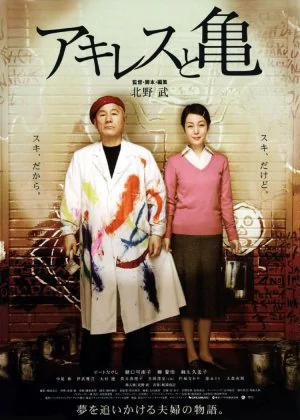Achilles and the Tortoise

After two introspective films before Achilles and the Tortoise [Achilles to Kame], Kitano is back to complete his trilogy. With Takeshis' he explored himself as an actor, Kantoku: Banzai! revealed Kitano as a troubled filmmaker and Achilles and the Tortoise, third in line, is telling us something about Kitano as a painter. And art. Or non-art, for that matter.

The film starts of rather slow. Kitano seems to reach back to the feel-good 50s try-outs he made in Kantoku: Banzai! Soft lightning and swift switches between humor, slices of life and drama of the poor make up most of the first 30 minutes. A few scarce moments remind us we are watching a Kitano film, most of them coming from the interaction between the young kid and the village retard. Scenes that are not unlike the ones between the grandpa and little girl in Ishii's Taste of Tea.
While those first thirty minutes are quite pleasant, the humor is warm and comforting and the score is pretty spot on (staying very close to the work of former Kitano regular Hisaishi), as a Kitano flick the film is definitely missing something vital. That something is added when we jump a couple of years forward to the painter's college years. It is obvious that Kitano's style starts to flourish in a more modern Japanese environment.
This is also the time when things start to go wrong for our young painter. Up until then he has been following his heart, making the paintings he likes best. But apparently, that is not to the liking of the young art dealer who is asked to sell his work and our young painter is urged to start following art lessons. He begins learning about art, which kick-starts his everlasting journey to grasp to concept of Art (with a capitol A).

Visually this second part is much more like the films that made Kitano famous. Static camera views, harsh lighting and many shots of stark facial expressions. The structure too becomes more like his older work, reminding me a lot of Kikujiro. Where the first parts grounds the trip the main characters are about to make, the core of the film lies in the sketchy scenes that follow. Our young painter teams up with his classmates and through several (often very funny) attempts eh tries to capture the core of art, spirit and originality.
After this second part the film jumps to the current time, Kitano himself (of course) portraying the painter as someone who has lost touch with reality, still running behind this idealized image of capturing the essence of art. In this third part the film really starts to shine as Kitano himself can fool around to make the best of the scenes he's in. He is visibly enjoying himself as probably a couple of those scenes were largely improvised on set (remembering the docu I once watched on Kikujiro).
Kitano will always remain Kitano, no matter what character he plays, but since he's playing himself that's hardly a fault. Apart from that, his mannerisms and posture are gold in the comedy scenes. Still, Kitano's character starts to sink deeper and deeper to the point where the comfortable life around him is shattered to pieces, with Kitano unable to let go of his self-induced passion.

The first section of the film is obviously the weakest but important for Kitano's vision on the subject. The moment he goes to school to learn about art he loses his spirit and becomes a parody of what an artist is supposed to be. Kitano pretty much trashes artists, art dealers, self-indulged amateurs and buying customers alike as he questions and undermines the importance of art and its function in our society.
It is nice to see a director doing this so openly and directly. Even though the film revolves around Kitano as a painter, it is easy to broaden the perspective and to see this film as a comment on art and art appreciation in general. On how people approach art, want to understand art and want to profit from it. It is also good to see that Kitano can walk away from it in the end with a contented heart and a freed soul.
Achilles and the Tortoise is a film that combines the themes and topics of his two latest outings with the style and feel of his earlier work. The comedy is typical for Kitano, the acting (with a neat little cameo for Terajima), directing, structure and pacing are all very much like his earlier films too. Even the music seems to come right out of Hisaishi's office. It's very nice to see all these things come together to create something that feels like the current Kitano, bearing his past baggage and showing multiple sides of his personality as a director, while still remaining very consistent in style and feel.
A must for Kitano fans and probably art fans alike (as all paintings were made by Kitano himself and are apparently based on existing paintings). Probably not the best place to start for people not really familiar with Kitano's earlier work as a director, but as a fan of his directorial efforts this is a pretty complete and awesome film to behold.